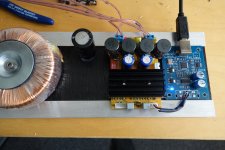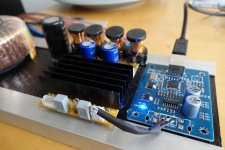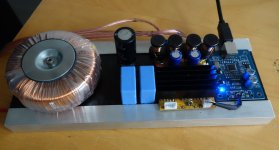I've not tried it with a 24V supply, highest I can go to is 20V if I use DC with the equipment I have. I'm pretty sure it's less heat. The board requires 36V for full 100W output.
I've now heatsinked them as they are burning hot! I mean, there's more heat from the inductors than the main IC at lower volume!
The heatsink is now at 80c!
Next I'm wondering if the input cap's on the 7498 are necessary. The input source is a USB dac which doesn't need them (I've bypassed the two silver electrolyics on the blue board).
You seem to trust the electronics. Please note that, without any analog volume control, one slight error might blow up your speakers as the amp has fully open volume. Analog volume control also will probably result in better sound quality than "digital"/electronic volume control.
Do they run cooler with a signal applied? (I noticed this with the TPA3251).
Do they heat up that much with the inputs grounded? (DAC disconnected) Maybe there's coming alot out-of-band-noise from the DAC, because of no lowpass-filter between the DACs output and the amps input. (So HF from the DAC is heating the inductors)
Do they heat up that much with the inputs grounded? (DAC disconnected) Maybe there's coming alot out-of-band-noise from the DAC, because of no lowpass-filter between the DACs output and the amps input. (So HF from the DAC is heating the inductors)
Maybe there's coming alot out-of-band-noise from the DAC, because of no lowpass-filter between the DACs output and the amps input. (So HF from the DAC is heating the inductors)
Seems a little far fetched with ES9023. There seem to be filter caps on the PCB.
In my limited experience, ferrite cored inductors fitted to el-cheapo amp boards are extremely lossy (aka cheapo). Hence run hot even with zero signal. To get the amp to run cool, seek out a Coilcraft inductor of the same value and size. You'll probably pay close to the original price of the board for a set of 4.
I bought a cheap TDA7498 board also, with apparently very similar ferrite inductors, but they stay cool.
Coilcraft is a manufacturer, not a type. Some of them are good for this application, others are not.
There are good ferrit cored inductors and iron powder cored too. This is not the difference either.
Some people think low DC is the key, but they are wrong. The most important factor here is low eddy current. Unfortunately it is not specified for none of the inductors. But there is a design tradeoff for inductors: you can keep low either DC loss or AC loss, but to keep them both low needs more expensive materials or bigger size or both. So you can find a low AC loss inductor easier among high DCR types.
Seems a little far fetched with ES9023. There seem to be filter caps on the PCB.
Never say never.

Seems a little far fetched with ES9023. There seem to be filter caps on the PCB.
Those filter caps are bypassed (shorted) as the ES9023 doesn't need them, however it is a valid point and one I did not think to check. I'll get to it.
However looking at the 7498 schematic it should use small caps to ground any high frequency noise on the input.
My speakers are Q Accoustic 3050's, should comfortably handle the full output of the 7498 should it occur.
Last edited:
Hmm, these caps normally go to ground, so having them shorted would short the output as well. Are you talking about the coupling caps?
If the inductors heat up that much without the DAC connected AND amp's inputs grounded, it's not a DAC thing. Would check that first.
If the inductors heat up that much without the DAC connected AND amp's inputs grounded, it's not a DAC thing. Would check that first.
I can confirm with input grounded / DAC off the inductors continue to heat. Much more heat than the main chip with no signal.
Hmm, these caps normally go to ground, so having them shorted would short the output as well. Are you talking about the coupling caps?
If the inductors heat up that much without the DAC connected AND amp's inputs grounded, it's not a DAC thing. Would check that first.
Yep sorry, the silver electrolytics on the USB DAC. No need for these as the ES chip has no DC bias (so I read).
And there should be noise shorting caps on the 7498 board. I can't be sure right now but it looks like there is.
Or
http://uk.rs-online.com/web/p/leaded-inductors/2335370/?origin=PSF_433015|alt
Edit: ordered, shall see how it goes.
http://uk.rs-online.com/web/p/leaded-inductors/2335370/?origin=PSF_433015|alt
Edit: ordered, shall see how it goes.
Last edited:
Add to the list, core saturation. This small choker are made for lower voltages SMPS, perhaps less than 5V peak to peak. If you use them at ±24V, they may be saturated.
Coilcraft is a manufacturer, not a type. Some of them are good for this application, others are not.
I'm aware Coilcraft is a manufacturer so did I express my meaning inadequately here? I meant to find a Coilcraft manufactured inductor which was electrically and physically compatible with those currently fitted. Probably the MSS1210 series.
Some people think low DC is the key, but they are wrong. The most important factor here is low eddy current. Unfortunately it is not specified for none of the inductors. But there is a design tradeoff for inductors: you can keep low either DC loss or AC loss, but to keep them both low needs more expensive materials or bigger size or both. So you can find a low AC loss inductor easier among high DCR types.
I agree here, low eddy current (= low core loss) at the operating frequency is crucial. Higher DCR may well mean lower copper losses ( skin/proximity effects reduced with thinner wire) wrt frequency but I can't see a reason higher DCR would affect the core losses. Do you know one? Perhaps you're of the view that eddy currents occur in both the copper and the core?
Add to the list, core saturation. This small choker are made for lower voltages SMPS, perhaps less than 5V peak to peak. If you use them at ±24V, they may be saturated.
I looked at the datasheet but there was nothing on it for voltage saturation.
Will give them a whirl and see what happens. Can't be any worse than the current chokes.
I'm aware Coilcraft is a manufacturer so did I express my meaning inadequately here? I meant to find a Coilcraft manufactured inductor which was electrically and physically compatible with those currently fitted. Probably the MSS1210 series.
This was I would have like to see, a specific series. And this one is good. The online tool estimates 0.18W loss. But there are other, not so apropriate series also, and probably better ones.
I agree here, low eddy current (= low core loss) at the operating frequency is crucial. Higher DCR may well mean lower copper losses ( skin/proximity effects reduced with thinner wire) wrt frequency but I can't see a reason higher DCR would affect the core losses. Do you know one?
Yes. Indirectly, due to a design tradeoff: to decrease core loss a low Al is set (by increasing gap height, concentrated in ferrite or distributed gap in powder cores). Low Al requires longer wire and there is less cross section is left, so DCR is increased. But your other guess is also correct:
Perhaps you're of the view that eddy currents occur in both the copper and the core?
Yes, eddy current flows inside copper also. Skin effect and proximity effect are specific forms of these currents. In a tipical classD output filter proximity effect dominates.
Decades ago the higher eddy current loss arised in cores. But nowadays the materials (especially metal powders) become much better. But copper stays the same. Litz wire and other special winding technics can help reducing eddy current in wire, but these are pricey.
Or
ELC18B220L | Panasonic 22 μH 10% Ferrite Leaded Inductor, 5.4A Idc, 25mΩ Rdc ELC18B | Panasonic
Edit: ordered, shall see how it goes.
It will be colder, but I wouldnt recommend it because of the open magnetic path. You can try and see. Probably usable, but not the best.
- Status
- Not open for further replies.
- Home
- Amplifiers
- Class D
- TDA7492 Inductor Heat


